

FIELD MARKINGS
- Field surface:
- Dimensions:
The field of play must be rectangular. The length of the touch line must be greater than the length of the goal line.
Length: minimum 90 m (100 yds) - maximum 120 m (130 yds)
Width: minimum 45 m (50 yds) - maximum 90 m (100 yds)
- International Matches:
Length: minimum 100 m (110 yds) - maximum 110 m (120 yds)
Width: minimum 64 m (70 yds) - maximum 75 m (80 yds)
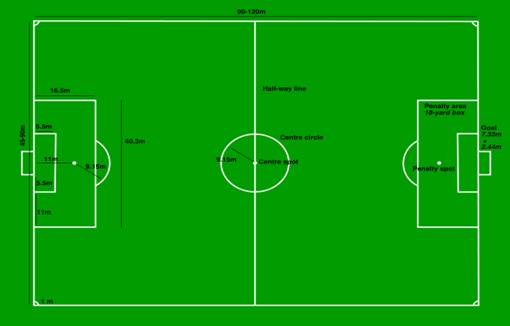
Equipment:
Ball
Spherical and made of leather or another suitable material.
 |
Goalkeeper gloves
Help in the handling of the ball.
 |
Goal
Consists of two upright posts joined at the top by a horizontal crossbar (2.44m by 7.32m - 8yds by 8ft). The goal is placed on the centre of each goal line.
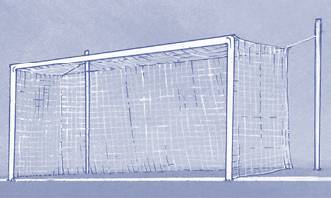
Uniforms:
The Corner Arc:

THE NUMBER OF PLAYERS:
Players:A match is played by two teams, each consisting of not more than eleven players, one of whom is the goalkeeper. A match may not start if either team consists of fewer than seven players.
Official Competitions:
Up to a maximum of three substitutes may be used in any match played in an official competition organized under the auspices of FIFA, the confederations or the member associations.
The rules of the competition must state how many substitutes may be nominated, from three up to a maximum of seven.
Changing the Goalkeeper:
Any of the other players may change places with the goalkeeper, provided that:
• the referee is informed before the change is made;
• the change is made during a stoppage in the match.
Each goalkeeper wears colors that distinguish him from the other players, the referee and the assistant referees.
THE DURATION OF THE MATCH:
1-Periods of Play
The match lasts two equal periods of 45 minutes, unless otherwise mutually agreed between the referee and the two participating teams. Any agreement to alter the periods of play (for example to reduce each half to 40 minutes because of insufficient light) must be made before the start of play and must comply with competition rules.
2-Half-Time Interval
Players are entitled to an interval at half-time. The half-time interval must not exceed 15 minutes. Competition rules must state the duration of the half-time interval. The duration of the half-time interval may be altered only with the consent of the referee.
3-Allowance for Time Lost
Allowance is made in either period for all time lost through:
- substitution(s);
- assessment of injury to players;
- removal of injured players from the field of play for treatment;
- wasting time;
- any other cause.
The allowance for time lost is at the discretion of the referee.
4-Penalty Kick
If a penalty kick has to be taken or retaken, the duration of either half is extended until the penalty kick is completed.
THE METHOD OF SCORING:
- Goal Scored
A goal is scored when the whole of the ball passes over the goal line, between the goalposts and under the crossbar, provided that no infringement of the Laws of the Game has been committed previously by the team scoring the goal.
- Winning Team
The team scoring the greater number of goals during a match is the winner. If both teams score an equal number of goals, or if no goals are scored, the match is drawn.
- Competition Rules
When competition rules require there to be a winning team after a match has been drawn, only the following procedures, which have been approved by the International F.A. Board, are permitted
Away goals rule;
Extra time;
Kicks from the penalty mark.
FREE KICKS:
1-Types of Free Kicks
Free kicks are either direct or indirect.
For both direct and indirect free kicks, the ball must be stationary when the kick is taken and the kicker does not touch the ball a second time until it has touched another player.
2-The Direct Free Kick
• If a direct free kick is kicked directly into the opponents’ goal, a goal is awarded.
• If a direct free kick is kicked directly into the team’s own goal, a corner kick is awarded to the opposing team.
3-The Indirect Free Kick
Signal
The referee indicates an indirect free kick by raising his arm above his head. He maintains his arm in that position until the kick has been taken and the ball has touched another player or goes out of play.
Ball Enters the Goal
A goal can be scored only if the ball subsequently touches another player before it enters the goal.
• If an indirect free kick is kicked directly into the opponents’ goal, a goal kick is awarded.
• If an indirect free kick is kicked directly into the team’s own goal, a corner kick is awarded to the opposing team.
THE PENALTY KICK:
1-A penalty kick is awarded against a team that commits one of the ten offences for which a direct free kick is awarded, inside its own penalty area and while the ball is in play.
A goal may be scored directly from a penalty kick.
Additional time is allowed for a penalty kick to be taken at the end of each half or at the end of periods of extra time.
2-Position of the Ball and the Players
The ball:
• is placed on the penalty mark.
The player taking the penalty kick:
• is properly identified.
The defending goalkeeper:
• remains on his goal line, facing the kicker, between the goalposts until the ball has been kicked.
The players other than the kicker are located:
• inside the field of play;
• outside the penalty area;
• behind the penalty mark;
• at least 9.15 m (10 yds) from the penalty mark
THE THROW-IN:
A throw-in is a method of restarting play.
A goal cannot be scored directly from a throw-in.
A throw-in is awarded:
• when the whole of the ball passes over the touch line, either on the ground or in the air;
• from the point where it crossed the touch line;
• to the opponents of the player who last touched the ball
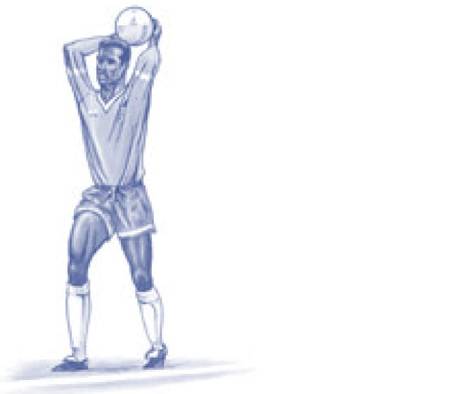
THE GOAL KICK:
A goal kick is a method of restarting play.
A goal may be scored directly from a goal kick, but only against the opposing team.
A goal kick is awarded when:
The whole of the ball, having last touched a player of the attacking team, passes over the goal line, either on the ground or in the air, and a goal is not scored in accordance with Law 10.
THE CORNER KICK:
A corner kick is a method of restarting play.
A goal may be scored directly from a corner kick, but only against the opposing team.
A corner kick is awarded when:
• the whole of the ball, having last touched a player of the defending
team, passes over the goal line, either on the ground or in the air, and a goal is not scored in accordance with Law 10.
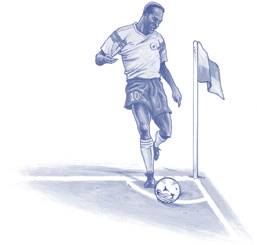
OFFSIDE:
It is not an offence in itself to be in an offside position.
A player is in an offside position if:
• he is nearer to his opponents’ goal line than both the ball and the second last opponent
A player is not in an offside position if:
• he is in his own half of the field of play; or
• he is level with the second last opponent; or
• he is level with the last two opponents.
Being offside:
When a player passes the ball and his assistances check the positions of the player’s attacking team-mates relative to the opposition defense and goalkeeper
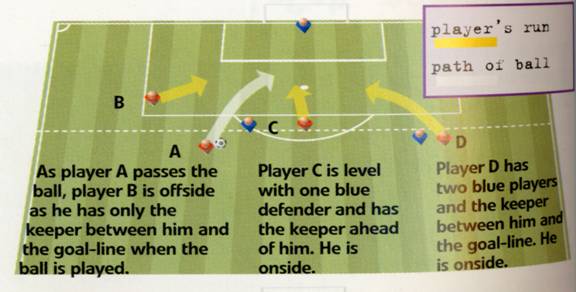
- Interfering with the play:
Being in an offside position does not mean that the referee will automatically stop play. He must decide whether you are also interfering with play


